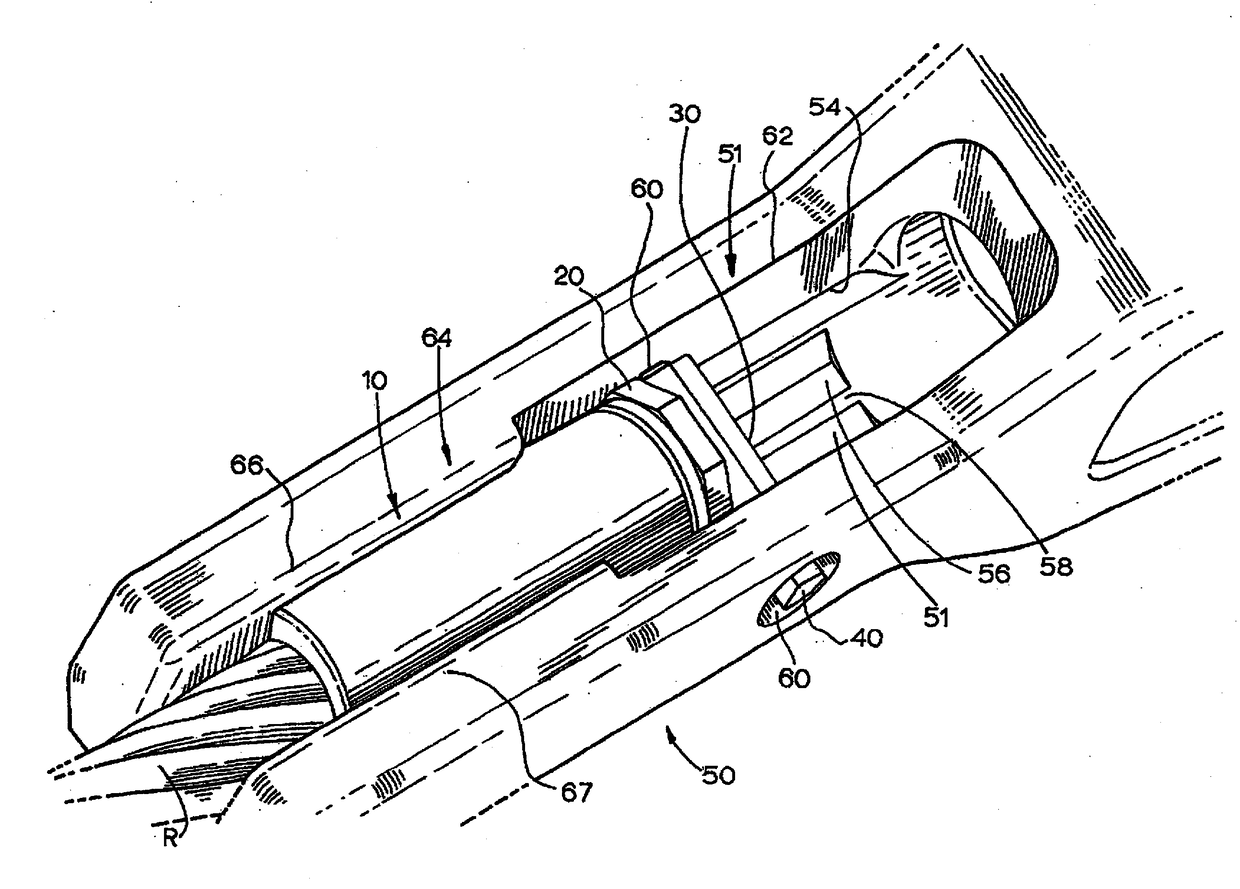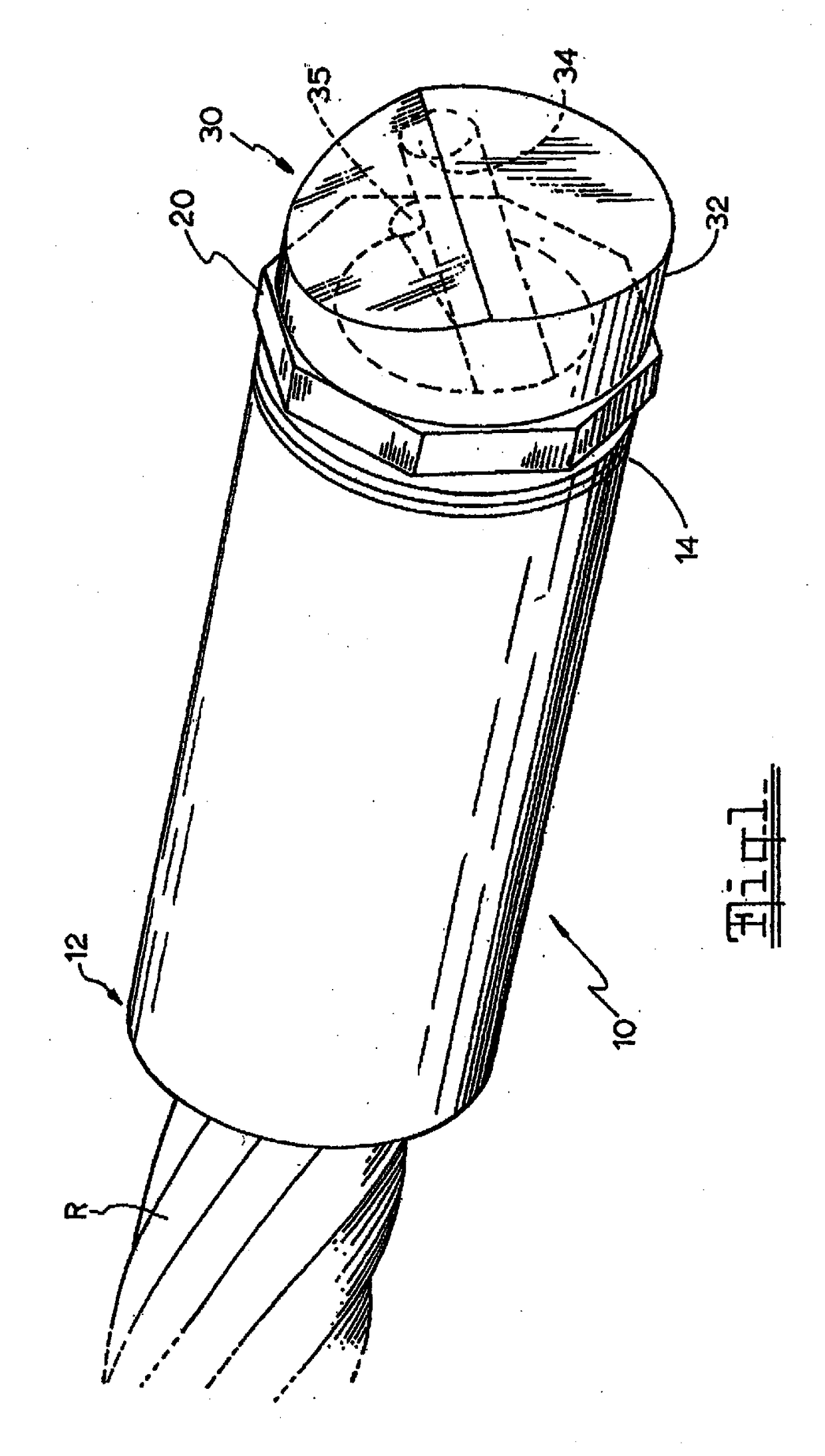Ferrule Retention
a technology of ferrules and ferrules, applied in the direction of ropes and cables for vehicles/pulleys, fastening means, textile cables, etc., can solve the problems of extreme and rapid wear of ropes, extreme force and load on dragline buckets, and time-consuming rope replacement, etc., to prolong the working life of ferrules
- Summary
- Abstract
- Description
- Claims
- Application Information
AI Technical Summary
Benefits of technology
Problems solved by technology
Method used
Image
Examples
example 1
[0129]A method of securing a ferrule 10 in a socket 50 comprised locating the ferrule so as to mate with the corresponding formation of the socket. In this regard, the ferrule was loaded (e.g. dropped) into the wider cavity section 62 of cavity 51. Usually prior to being so dropped, the ferrule and / or wire rope were first twisted or rotated just a small amount and sufficiently such that two opposing sides (e.g. 23 and 24) of plate 20 aligned with the opposing internal walls (e.g. 53 and 54) of the socket cavity.
[0130]The wire rope and / or socket were then pulled (or the ferrule was pushed such as by a tool) so that it moved back axially within cavity 51 to locate in narrower cavity section 64, to be retained under opposed lips 66, 67. The ferrule was now ready to be lockingly secured against axial movement within the socket.
example 2
[0131]In this example, the ferrule 10 was lockingly secured against axial movement within the socket by the locking block 30. The locking block 30 was dropped into the wider cavity section 62 of cavity 51. Alternatively, the locking block 30 was already pre-secured to the plate 20, so that it loaded into the cavity section 62 of cavity 51 together with the ferrule 10.
[0132]In either case, once the bolt hole 34 of block 30 aligned with the opposed socket holes 60, the bolt 40 was extended through the opposed socket holes 60 and bolt hole 34. When the groove 42 of bolt 40 aligned with the spring-pin hole 35, the spring-loaded retaining pin 37 was urged therein, so that part of its shaft located into groove 42. Thus, the block 30 became secured to the bolt 40, and the bolt became secured to the socket 50. The ferrule 10 and thus wire rope R were now securely retained and locked in the socket.
example 3
[0133]In this example, the ferrule 10 was lockingly secured against axial movement within the socket by the trapezoidal prism 570. The nut 581 was drivingly rotated by a power tool, moving inwards of the bolt 580. The drive elements 576 and 576′ were in turn caused to slide towards each other, whereby their side faces 577 respectively engaged and acted on each trapezoidal prism angled face 573, 574. This caused the trapezoidal prism 570 to be displaced within the socket towards the ferrule 10 until its major face 572 abutted the plate 20 at end 14 of the ferrule 10. The ferrule 10 and thus wire rope R were now securely retained and locked in the socket.
PUM
 Login to View More
Login to View More Abstract
Description
Claims
Application Information
 Login to View More
Login to View More - R&D
- Intellectual Property
- Life Sciences
- Materials
- Tech Scout
- Unparalleled Data Quality
- Higher Quality Content
- 60% Fewer Hallucinations
Browse by: Latest US Patents, China's latest patents, Technical Efficacy Thesaurus, Application Domain, Technology Topic, Popular Technical Reports.
© 2025 PatSnap. All rights reserved.Legal|Privacy policy|Modern Slavery Act Transparency Statement|Sitemap|About US| Contact US: help@patsnap.com



